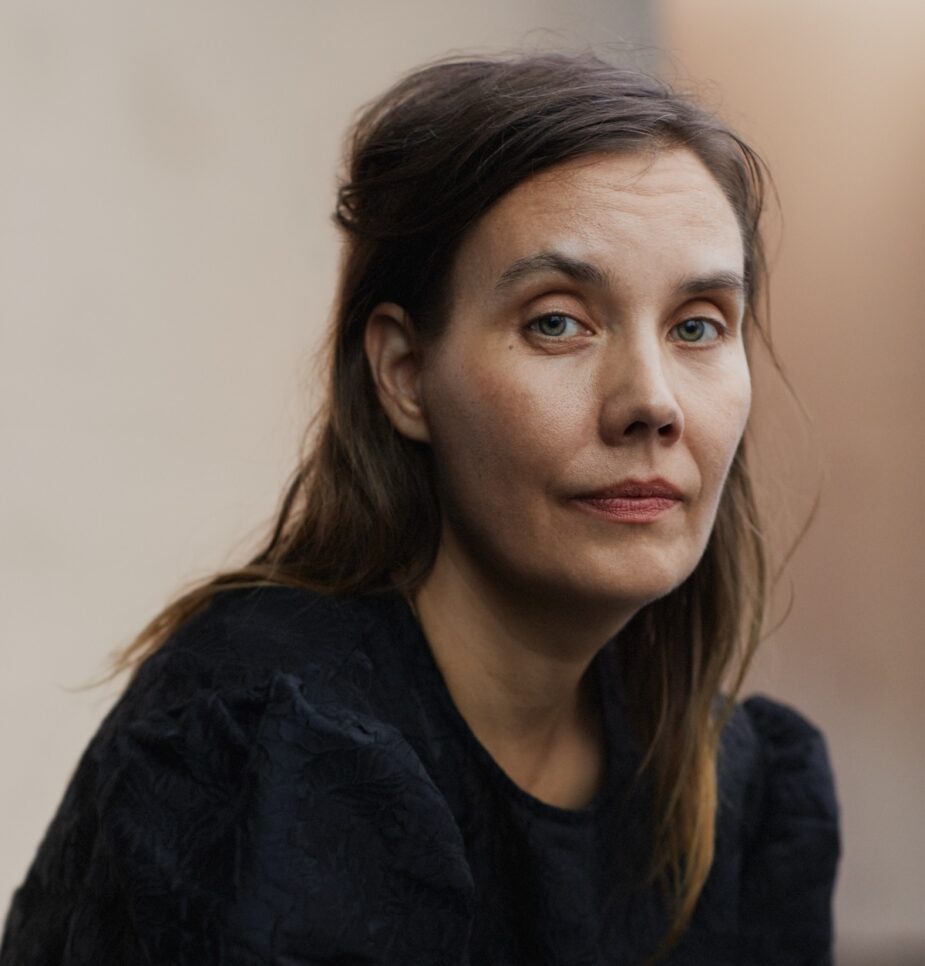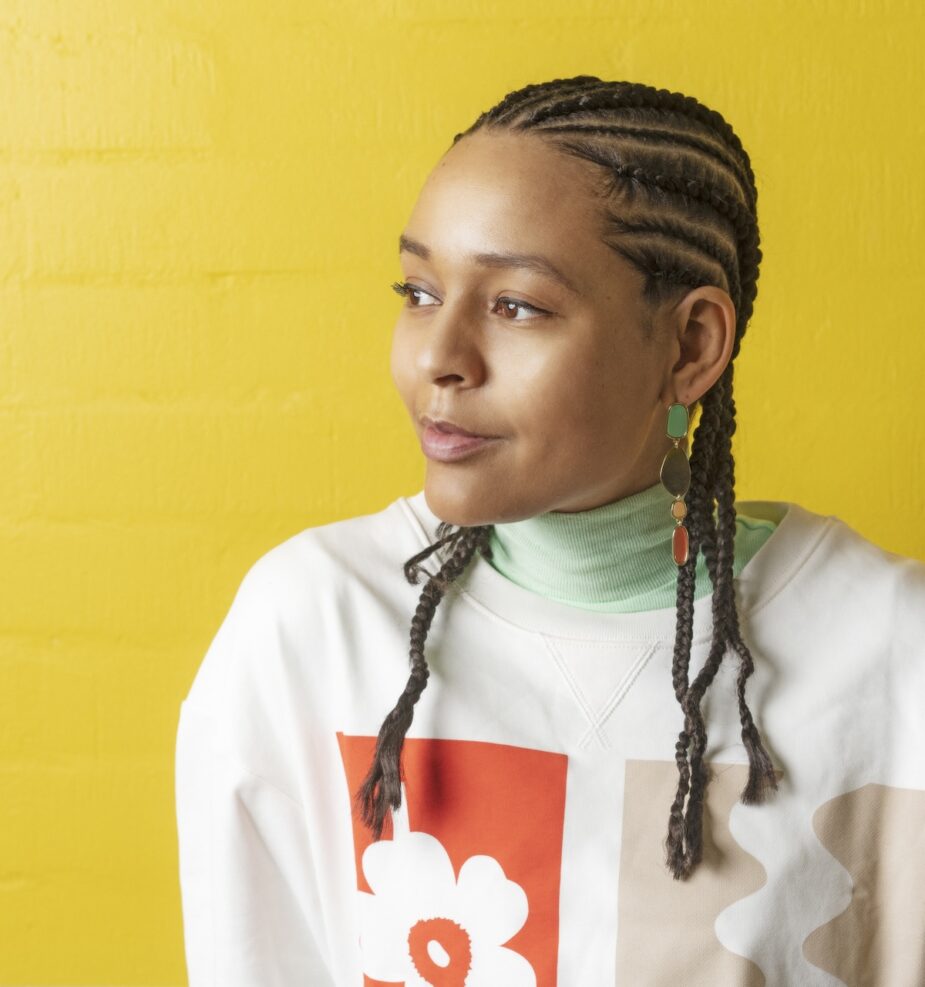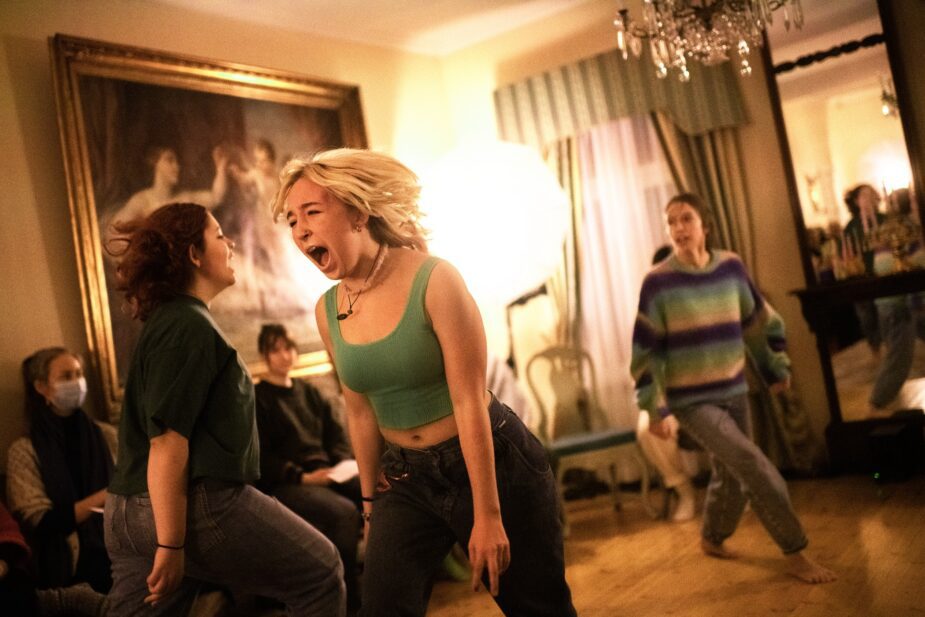When it comes to watching and participating in art, younger audiences – those in their teens – have categorically fallen by the wayside in comparison to other age groups. There are pieces tied to the age and interests of children from babies up to those of primary school age – and, of course, there is plenty out there for the working-age population and elderly people. It is only in recent years that young people have had the spotlight turned on them as an interesting potential target group for the performing arts, with dedicated quality pieces only now being created for them.
Text: Heidi Backström | Translation: Claire Ruaro
Three Finnish artists tell us what fascinates them about young audiences and what the art field should offer for them. The article was originally published in the Finnish Circus & Dance Magazine 2024 issue.
Janina Rajakangas: For and with young people, in their spaces

Photo: Ilkka Saastamoinen
Choreographer Janina Rajakangas started creating her piece Teen (2017, 2021–2022) when she became a bonus mother to a teenager. This change in her own life prompted her to start thinking about what teenage life is, how it feels, and what embodiment and communality in the teenage context really are.
“I feel that I cannot help but make work about what is around me, either bothering or intriguing me. I then create movement from the issue by embodying different aspects of it. In Teen, we created movement by embodying states related to teenagers like frustration, rage and affection towards other teens. I thought about how teenagers walk, or trundle along and how they hang out differently to how adults do,” Rajakangas explains.
Teen was a piece for teens and adults, and its performers were all high school students. The piece was first shown on stage for adult and art audiences at Zodiak – Centre for New Dance and went onto tour schools both in 2018 and 2021–2022.
At the heart of the piece were encounters: the performers were in the centre of the space, with the audience surrounding them on four sides. The performers looked into the audience’s eyes, creating encounters between performer and spectator. Rajakangas tells that initially eye contact was difficult for the teenagers, but as the piece progressed it grew easier.
Rajakangas continued working with the performers from Teen in her performance Venus, which premiered at the Baltic Circle festival in November 2022. Venus explores the eroticisation of girls and young women on social media, a topic that came to Rajakangas through her own teenaged daughter. By this stage, Rajakangas already knew what her performers were capable of and how close they could get to the audiences.
In Venus, the themes that teenaged girls explore are presented to the audiences in such a way that the audience cannot escape or avoid them, with no room for misunderstandings. “Soon after Venus premiered, it became clear that everyone has encountered harassment on social media, even if they do not talk about it. The very nature of harassment means that people don’t tell anyone about it.”
Originally, Venus was created primarily for fellow parents to help them see the reality faced by young women and to shine a light on topics that can be difficult to put into words. However, in autumn 2023, Venus was adapted for ninth-grade students. In this version, the performance took place on a stage, not surrounded by the audience as in the original version. “In the piece, the performers were so exposed that we needed a way to create distance, a mental buffer between them and the audience. The stage and microphones create that,” says Rajakangas, explaining the choices that must come into play with young performers.
Rajakangas feels that high school students in particular have a dire need for pieces that deal with the kinds of things they are experiencing in their lives. Performers of the same age are one way of approaching the topic: “Having a question posed to you by a peer is a powerful experience. In the world of dance, 20–30-year-olds are well represented, but other groups lack that peer experience.”
Read more about Janina Rajakangas and her work
In the Springback Magazine article by Anna Kozonina
In the Ice Hot Oslo 2024 programme
Choreographer in Focus 2022: Janina Rajakangas gets anxious teens and aging men moving (scroll down to the page 32)
Sonya Lindfors: Pedagogic performers – a direct connection with young people

Photo: Tuukka Ervasti
At the core of choreographer Sonya Lindfors’s practice is connecting with diverse audiences through art. Her ears are ringing with talk of young people being a special group: “It feels like anyone other than white, middle-class adults is considered a special group when it comes to art.”
Lindfors’s piece something like this has been created as a part of the Zodiak 2025 – Zodiak Youth Project, which breaks down the barriers between school age audiences and contemporary dance. The project involves, for example, experimenting with different ways of implementing performances aimed at young people and reaching new audiences. At the start of something like this, the working group came together to consider the question: what kind of performance would I have wanted to see as a teenager?
something like this is a performance featuring four big names in the Finnish street dance scene. Street dance is rarely seen on art stages and in art contexts: “These creators, techniques and worlds also belong on stages and by bringing them to such environments we can have a real impact on young people.” Lindfors herself has taught dance since she was 15 years old, and the other members of the something like this working group also have strong pedagogic backgrounds. Teaching offers a direct connection with young people as audiences.
There should be more diverse art and quite simply just more art available for youngsters.
Young audiences are also nothing new to Lindfors. Her pieces Cosmic latte, Noir and camouflage deal with topics such as gaze and Black body on the stage and have been performed at youth festivals. The process for creating something like this was guided by a desire to show off the best sides of street dance: encouragement, playfulness, happiness and the joy of doing things and dancing together, the joy of one’s own body. The background to this is Lindfors’s own experience of her transformation into an adult, a stage of life where art and dance truly kept her going. “My body can be exactly as it is, big or small, visible or on the sidelines.”
Read more about Sonya Lindfors’ work
Something like this is performed at Ateliers de Paris 25th May 2024
Artist in Focus 2024: Sonya Lindfors – Radical dreams (scroll to the page 28 in the Focus Magazine)
Race Horse Company: Permission to be entertained

‘Art Testers’ is a cultural education programme funded by two Finnish foundations – the Finnish Cultural Foundation and the Swedish Cultural Foundation in Finland – and the Ministry of Education and Culture, bringing all of the approximately 60,000 eighth graders in Finland to visit high-quality art locations around Finland every year. Artists and art organisations get direct feedback from the young people, allowing them to develop their content so that it truly speaks to young audiences.
Around 4,000 art testers in southern Finland saw contemporary circus group Race Horse Company’s Tattarmossen Experience in autumn 2023. Tattarmossen Experience is a performance about people who live on the outskirts of town, in homes they have built themselves from rubbish. The inspiration for the piece came from the Tattarmossen neighbourhood in Helsinki, where RHC’s training facilities were located. The industrial aesthetics of the area and extraordinary human fates are clear to see in this comedic performance.
The group wanted to make a piece that was unambiguously comedic, a show that anyone could enjoy. While the piece is not suitable for the very youngest members of the family, it is open to anyone else. “It embraces slapstick humour and fart jokes, the kind that don’t offend anyone and get everyone laughing,” explain Rauli Dahlberg and Kalle Lehto from RHC.
They love to amaze audiences who have arrived with the presumption of ‘ugh, theatre. Yawn.’
“Teens like it because there’s plenty happening on stage. It proceeds at quite the pace, so it holds the audience’s interest. Technically challenging moves really capture people’s interest,” Dahlberg and Lehto state, pondering the reasons Tattarmossen Experience works so well for young audiences. “In this piece, we weren’t aiming for deep artistic themes or trying to refine it into something aesthetically profound, instead the tempo and the moves were the key elements. You don’t need to understand the deepest essence of art or some social phenomenon, instead you can just switch your brain off and enjoy it.” Despite this, the teens surprised the artists by sharing all kinds of deep thoughts about the piece.
RHC considers it important for young people to be offered ways to be surprised and get adrenaline rushes from sources other than screens. They love to amaze audiences who have arrived with the presumption of ‘ugh, theatre. Yawn.’ “Then when they get into the theatre they’re reacting, clapping and laughing, really having those wow moments.”
Increasing accessibility, diversity and provision
Janina Rajakangas, Sonya Lindfors and Race Horse Company’s Rauli Dahlberg and Kalle Lehto all feel that high-quality art can and should be provided in young people’s own spaces, such as schools. An active approach should also be taken to bringing young people into art institutions, allowing them to be involved in art even as young adults.As Lindfors summarises: “There should be more diverse art and quite simply just more art available for youngsters. Diversity in terms of the artists and the content. More pieces that young spectators can enjoy and more works that allow them to challenge themselves. By making these changes we can allow every young person to find their own space in the field of arts, as a creator, as a spectator, as a participator.”
